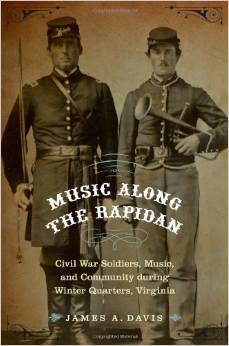Music Along the Rapidan: Civil War Soldiers, Music, and Community during Winter Quarters, Virginia by James A. Davis. University of Nebraska Press, 2014. Cloth, ISBN: 978-0803245099. $45.00.
 In the course of arguing that music fundamentally shaped the material and social environments of Civil War Americans, musicologist James A. Davis makes a strong case for sensory history. Without hearing the music of soldiers, nearby civilians, and the interplay between the two, scholars miss an important locus of community and insight into the transformation from citizen to soldier. The sounds of military regimentation, around campfires, at social balls, and in religious meetings all become vehicles for Davis to explore how music “reaffirmed or contested” preexisting, new, and incipient communities (3). His case study centers on the five months of winter camp, 1863-64, along the Rapidan River in which the Army of Northern Virginia and the Army of the Potomac interacted with the surrounding Orange and Culpepper counties. Thus, the work speaks not only to the “emotional and social power” of music, but also to the larger experience of prolonged encampment, a period of soldiering often neglected by scholars, but which presents excellent opportunity to reveal the “communal identities produced by the war” (4).
In the course of arguing that music fundamentally shaped the material and social environments of Civil War Americans, musicologist James A. Davis makes a strong case for sensory history. Without hearing the music of soldiers, nearby civilians, and the interplay between the two, scholars miss an important locus of community and insight into the transformation from citizen to soldier. The sounds of military regimentation, around campfires, at social balls, and in religious meetings all become vehicles for Davis to explore how music “reaffirmed or contested” preexisting, new, and incipient communities (3). His case study centers on the five months of winter camp, 1863-64, along the Rapidan River in which the Army of Northern Virginia and the Army of the Potomac interacted with the surrounding Orange and Culpepper counties. Thus, the work speaks not only to the “emotional and social power” of music, but also to the larger experience of prolonged encampment, a period of soldiering often neglected by scholars, but which presents excellent opportunity to reveal the “communal identities produced by the war” (4).
The book is at its strongest when examining how military music ushered citizens into soldiers. Routine camp calls, drills, and ceremonies governed the very structure of men’s lives much to their irritation, but at the same time, reinforced “the bonding process” crucial to army cohesion (72). These musical rituals further enabled soldiers to process and cope with the challenges of their service. At funeral services, soldiers could mourn the pain of attrition from sickness, wounds, and death. Dress parade allowed soldiers to be admired and thanked for their sacrifices. Even solemn executions served to remind men of the gravity of resisting the rigid boundaries of military discipline.
Davis offers equally strong insights into how music helped to integrate disparate ethnic and geographic identities into a coherent fighting force, though class divisions proved harder to transcend. He finds that ethnic songs wooed suspicious soldiers to more sympathy toward their Irish and German comrades. When it came to overcoming geographical divides, shared patriotic songs created a sense of national unity in the armies—particularly among Confederates whose country was new. Certain songs, such as “Johnny Has Gone for a Soldier,” were common to both sides, drawing upon a shared past, but others emphasized the differences between the two nations, such as the Southern “Bonnie Blue Flag” or the Northern “Battle Cry of Freedom.” Despite the unifying powers of music, the divisions between the elite and their social inferiors remained stark as ever, evidenced by military balls. Even renowned soldiers from humble backgrounds, such as Nathan Bedford Forrest, who had risen from poverty to fortune before the war, “ran into a glass ceiling within the Confederate high command as he lacked a West Point education and did not mingle with high society” (117).
In the vein of recent military occupation studies, Davis effectively observes interactions between the home front and warfront in winter camp, a phase with potential to strain social relations. Civilians sometimes visited soldier revival meetings as did soldiers attend local church services, both of which provided opportunities for religious music to serve as a bridge between disparate wartime experiences. An entire chapter investigates how military brass bands—a popular cultural phenomenon of the time, with their expensive instruments and skilled musicians—attracted broad civilian audiences, smoothing over the tensions that could arise between raucous encampments and civilian life.
Further, as African Americans mingled with soldiers via the local economy or as contrabands in the Union camp, the exchange of white and black music provided a less-contentious venue through which to experience racial interaction. Indeed, in the case of soldier-produced minstrel shows, white federals probed their insecurities regarding emancipation by creating a “tenuous middle space between black tradition and white commercialization” (185).
On the whole, Davis’ work is evidence-forward, resulting in some cumbersome repetitions in the text, and his music- and identity-centered analysis at times feels foreign to historians, given our propensity toward historical context. Intriguing themes of nationalism, the evolution of citizen-soldier, and racial, class-based, and ethnic strife in the ranks could have been better developed through secondary literature. Though the author explicitly chose to focus on winter camp and cannot be faulted for fulfilling his purpose, his analysis would have been so welcome to Civil War combat that I could not help but regret the chosen parameters. If music fundamentally shaped the identities of armies and combat proved the test of armies’ training and mettle, could a bugle call restore a crumbling unit? Did camp music help to process victory and defeat after a battle? Nevertheless, it takes a well-researched monograph like Davis’ to convince Civil War historians that we really should be listening to our subjects as well as reading them.
Kathryn Shively Meier is Assistant Professor of History at Virginia Commonwealth University and the author of Nature’s Civil War (2013).
